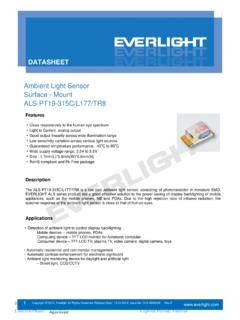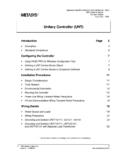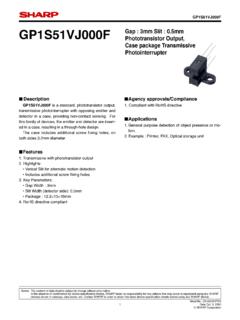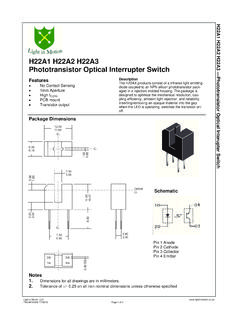Transcription of 3mm Photodiode PD204-6C/L3 - Everlight Electronics
1 1 Copyright 2010, Everlight All Rights Reserved. Release Date : Issue No: DPD-00000152. 3mm Photodiode PD204-6C/L3 Features Fast response time High photo sensitivity Small junction capacitance Pb free This product itself will remain within RoHS compliant version. Compliance with EU REACH Description PD204-6C/L3 is a high speed and high sensitive PIN Photodiode in a standard 3 plastic package. The device is Spectrally matched to visible and infrared emitting diode. Applications Automatic door sensor Copier Game machine DATASHEET 3mm Photodiode PD204-6C/L3 2 Copyright 2010, Everlight All Rights Reserved.
2 Release Date : Issue No: DPD-0000152, Device Selection Guide Chip Materials Lens Color Silicon Black Absolute Maximum Ratings (Ta=25 C) Parameter Symbol Rating Unit Reverse Voltage VR 32 V Operating Temperature Topr -25 ~ +85 C Storage Temperature Tstg -40 ~ +100 C Soldering Temperature(*1) Tsol 260 C Power Dissipation at (or below) 25 CFree Air Temperature Pc 150 mW Notes: *1:Soldering time 5 3mm Photodiode PD204-6C/L3 3 Copyright 2010, Everlight All Rights Reserved. Release Date : Issue No: DPD-0000152, Electro-Optical Characteristics (Ta=25 C) Parameter Symbol Min. Typ. Max. Unit Condition Range Of Spectral Bandwidth 760 ----- 1100 nm ----- Wavelength Of Peak Sensitivity P ----- 940 ----- nm ----- Open-Circuit Voltage VOC ----- ----- V Ee=1mW/cm2 p=940nm Short- Circuit Current ISC ----- ----- A Ee=1mW/cm2 p=940nm Reverse Light Current IL 6 A Ee=1mW/cm2 p=940nm VR=5V Reverse Dark Current ID ---- ---- 10 nA Ee=0mW/cm2 VR=10V Reverse Breakdown Voltage VBR 32 170 A Ee=0mW/cm2 IR=100 A Total Capacitance Ct ----- 10 ----- pF Ee=0mW/cm2 VR=5V f=1 MHz Rise Time/ Fall Time tr/ / tf ----- 10/10 ----- ns VR=10V RL=100 View Angle 2 1/2 ----- 45 ----- deg IF=20mA Note: Tolerance of Luminous Intensity.
3 10% Tolerance of Dominant Wavelength: 1nm Tolerance of Forward Voltage: DATASHEET 3mm Photodiode PD204-6C/L3 4 Copyright 2010, Everlight All Rights Reserved. Release Date : Issue No: DPD-0000152, Typical Electro-Optical Characteristics Curves Power Dissipation vs. Ambient Temperature Spectral Sensitivit Reverse Dark Current vs. Ambient Temperature Reverse Light Current vs. Ee DATASHEET 3mm Photodiode PD204-6C/L3 5 Copyright 2010, Everlight All Rights Reserved. Release Date : Issue No: DPD-0000152, Terminal Capacitance vs. Reverse Voltage Response Time vs. Load Resistance DATASHEET 3mm Photodiode PD204-6C/L3 6 Copyright 2010, Everlight All Rights Reserved.
4 Release Date : Issue No: DPD-0000152, Package Dimension Note: Tolerances unless dimensions DATASHEET 3mm Photodiode PD204-6C/L3 7 Copyright 2010, Everlight All Rights Reserved. Release Date : Issue No: DPD-0000152, Packing Quantity Specification ~1000 PCS/1 Bag 4 Bags/1 Box Label Form Specification CPN: Customer s Product Number P/N: Product Number QTY: Packing Quantity CAT: Luminous Intensity Rank HUE: Dom. Wavelength Rank REF: Forward Voltage Rank LOT No: Lot Number X: Month Reference: Identify Label Number DATASHEET 3mm Photodiode PD204-6C/L3 8 Copyright 2010, Everlight All Rights Reserved.
5 Release Date : Issue No: DPD-0000152, Preheadlaminar waveFluxing1. Lead Forming During lead formation, the leads should be bent at a point at least 3mm from the base of the epoxy bulb. Lead forming should be done before soldering. Avoid stressing the LED package during leads forming. The stress to the base may damage the LED s characteristics or it may break the Photodiode . Cut the LED leadframes at room temperature. Cutting the leadframes at high temperatures may cause failure of the Photodiode . When mounting the Photodiode onto a PCB, the PCB holes must be aligned exactly with the lead position of the LED. If the Photodiode are mounted with stress at the leads, it causes deterioration of the epoxy resin and this will degrade thePhotodiode.
6 2. Storage The Photodiode should be stored at 30 C or less and 70%RH or less after being shipped from Everlight and the storage life limits are 3 months. If the Photodiode are stored for 3 months or more, they can be stored for a year in a sealed container with a nitrogen atmosphere and moisture absorbent material. Please avoid rapid transitions in ambient temperature, especially, in high humidity environments where condensation can occur. 3. Soldering Careful attention should be paid during soldering. When soldering, leave more then 3mm from solder joint to epoxy bulb, and soldering beyond the base of the tie bar is recommended. Recommended soldering conditions: Hand Soldering DIP Soldering Temp.
7 At tip of iron 300 C Max. (30W Max.) Preheat temp. 100 C Max. (60 sec Max.) Soldering time 3 sec Max. Bath temp. & time 260 Max., 5 sec Max Distance 3mm Min.(From solder joint to epoxy bulb) Distance 3mm Min. (From solder joint to epoxy bulb) Recommended soldering profile DATASHEET 3mm Photodiode PD204-6C/L3 9 Copyright 2010, Everlight All Rights Reserved. Release Date : Issue No: DPD-0000152, Avoiding applying any stress to the lead frame while the Photodiode are at high temperature particularly when soldering. Dip and hand soldering should not be done more than one time After soldering the Photodiode , the epoxy bulb should be protected from mechanical shock or vibration until thePhotodiode return to room temperature.
8 A rapid-rate process is not recommended for cooling the Photodiode down from the peak temperature. Although the recommended soldering conditions are specified in the above table, dip or handsoldering at the lowest possible temperature is desirable for the Photodiode . Wave soldering parameter must be set and maintain according to recommended temperature and dwell time in the solder wave. 4. Cleaning When necessary, cleaning should occur only with isopropyl alcohol at room temperature for a duration of no more than one minute. Dry at room temperature before use. Do not clean the Photodiode by the ultrasonic. When it is absolutely necessary, the influence of ultrasonic cleaning on the Photodiode depends on factors such as ultrasonic power and the assembled condition.
9 Ultrasonic cleaning shall be pre-qualified to ensure this will not cause damage to the LED 5. Circuit Protection Below the zener reference voltage Vz, all the current flows through LED and as the voltage rises to Vz, the zener diode breakdown." If the voltage tries to rise above Vz current flows through the zener branch to keep the voltage at exactly Vz. When the LED is connected using serial circuit, if either piece of LED is no light up but current can t flow through causing others to light down. In new design, the LED is parallel with zener diode. if either piece of LED is no light up but current can flow through causing others to light up.
10 6. Heat Management Heat management of Photodiode must be taken into consideration during the design stage of LED application. The current should be de-rated appropriately by referring to the de-rating curve found in each product specification. The temperature surrounding the LED in the application should be controlled. Please refer to the data sheet de-rating curve. 7. ESD (Electrostatic Discharge) Electrostatic discharge (ESD) or surge current (EOS) can damage Photodiode An ESD wrist strap, ESD shoe strap or antistatic gloves must be worn whenever handling Photodiode All devices, equipment and machinery must be properly grounded. Use ion blower to neutralize the static charge which might have built up on surface of the Photodiode plastic lens as a result of friction between Photodiode during storage and handing.












